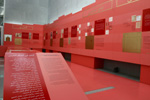 Owing to their conquests in the seventh and eighth centuries, the Arabs gained access to scientific texts, the majority of which were Greek. A great translation movement accompanied these conquests and Arabic soon became the language of all sciences. Under the patronage of caliphs, scientists and physicians embarked on significant scientific progress.
Owing to their conquests in the seventh and eighth centuries, the Arabs gained access to scientific texts, the majority of which were Greek. A great translation movement accompanied these conquests and Arabic soon became the language of all sciences. Under the patronage of caliphs, scientists and physicians embarked on significant scientific progress.
Presented in chronological order are:
Al-Khwarizmiy, Banu-Musa, Thabit bin-Qurra, Abu-Kamil, Ibn Yunus, Ibn al-Haytham, al-Muradiy, al-Jazariy, Ibn al-Shatir, al-zarqaliy, al-Idrisiy.
Physicians and naturalists:
Al-Raziy, al-Zahrawiy, Ibn Ridwan, Ibn Butlan, Ibn al-Baytar, Ibn al-Nafis.
Frame-freezes:
Heralding the Renaissance through the evocation of three west-European scientists, whose researches were extensions to earlier ones: Leonardo da Vinci, Copernicus and Harvey.